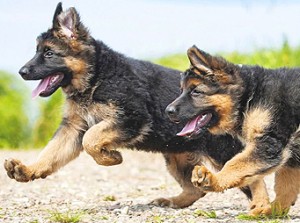Working Dogs – You May Own One and Not Know It!
178 – October, 2017
By Dr. Carmen L. Battaglia
 Since the beginning of domestication, humans have inten- tionally and unintentionally modified the purpose, function, structure and behavior of dogs, resulting in the development of more than 400 breeds. Ownership has spread across the globe. In the UK, 31% of human households own a dog. In the US and Australia, 36% own dogs, and in Japan it is more than 19%. In such diverse environments it is not surprising that many breeds have been developed to serve a variety of specialized and unique roles. Breed functions have been extended from that of a hunter, partner and companion to a protector and detector. Their roles within each of these functions have also included a wide range of behaviors and phenotypes. Many of today’s canines have be- come superior athletes, sound in temperament and skilled at many tasks. This group of unique specimens have been labeled “work- ing dogs”. The term defines a behavior and skill based on their special uses which often exceed that of equipment used on airport screening. Their work environment includes war and peace time, and in many ways these dogs are better equipped than humans. What makes them so unique is their portability, loyalty and trust- worthiness. This paper addresses the need for working dogs and why they are being used to support a national interest.
Since the beginning of domestication, humans have inten- tionally and unintentionally modified the purpose, function, structure and behavior of dogs, resulting in the development of more than 400 breeds. Ownership has spread across the globe. In the UK, 31% of human households own a dog. In the US and Australia, 36% own dogs, and in Japan it is more than 19%. In such diverse environments it is not surprising that many breeds have been developed to serve a variety of specialized and unique roles. Breed functions have been extended from that of a hunter, partner and companion to a protector and detector. Their roles within each of these functions have also included a wide range of behaviors and phenotypes. Many of today’s canines have be- come superior athletes, sound in temperament and skilled at many tasks. This group of unique specimens have been labeled “work- ing dogs”. The term defines a behavior and skill based on their special uses which often exceed that of equipment used on airport screening. Their work environment includes war and peace time, and in many ways these dogs are better equipped than humans. What makes them so unique is their portability, loyalty and trust- worthiness. This paper addresses the need for working dogs and why they are being used to support a national interest.
National Shortage
In modern societies, dogs have become one of the primary tools used to support national security. Unfortunately, here in the United States they are in very short supply because for more than 30 years our country has relied on breeders in Europe to supply our needs. Since 911 the need for dogs has steadily increased be- cause terrorism has continued to exploit the vulnerabilities of countries. Recent attacks in Paris and at the Brussels Zaventem and Istanbul Ataturk airports demonstrate that aviation systems remain their primary targets. The terrorists have also demon- strated their capabilities to become more sophisticated as they seek to circumvent our technology systems. This has made the canine’s nose one of our best lines of defense. Their contributions to national security along our borders, at ports of entry, in our air- ports and beyond continue to grow. In fiscal year 2016, TSA ca- nine teams screened approximately 26 million passengers and responded to requests to check 35,000 unattended items. In re- sponse to threats of terrorists, the US Department of Homeland Security (DHS) maintains a robust canine program with teams ranging from patrol units with the US Secret Service and explo- sive detection units with the Coast Guard and TSA, to Urban Search and Rescue units with FEMA. The US Customs and Bor- der Patrol has approximately 1,500 canine teams–which is con- sidered by many to be the largest canine program at DHS–with many missions that include tactical operations for the detection of narcotics, firearms, undeclared currency, concealed persons and the illegal, undeclared agricultural products which have the potential to wreak havoc on U.S. agricultural resources.
Click here to read the complete article178 – October, 2017
Short URL: http://caninechronicle.com/?p=133738
Comments are closed











